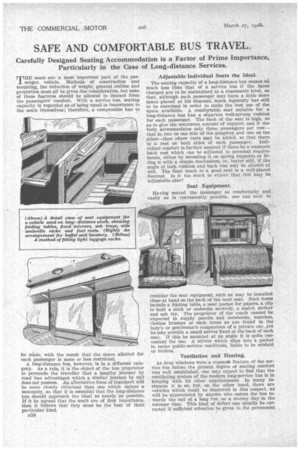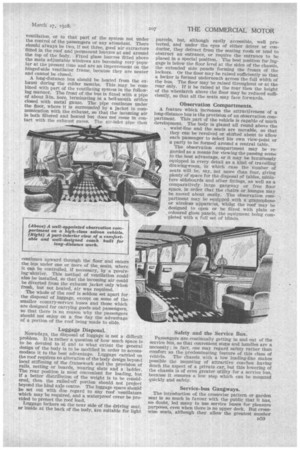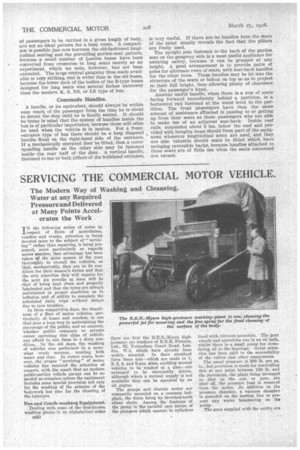• SAFE AND COMFORTABLE BUS TRAVEL.
Page 120

Page 121

Page 122

If you've noticed an error in this article please click here to report it so we can fix it.
Carefully Designed Seating Accommodation is a Factor of Prime Importance, Particularly in the Case of Long-distance Services.
seats are a most important part of the pas senger. vehicle. Methods of construction and mounting, the reduction of weight, general outline and proportion must all be given due consideration, but none of these features should be allowed to detract from the passengers' comfort. With a service bus, seating capacity is regarded as of being equal in importance to the seats themselves; therefore, a compromise has to be made, with the result that the space allotted for each passenger is more or less restricted.
A long-distance bus, however, is in a different category. As a rule, it is the object of the bus proprietor to persuade the traveller that a lengthy journey by road has advantages which a similar journey by rail does not possess. An alternative form of transport will be more closely criticised than one which enjoys a monopoly, so that it is essential that the long-distance bus should approach the ideal as nearly as possible. If it be agreed that the seats are of first importance, then it follows that they must be the best of their particular kind.
D58
Adjustable Individual Seats the Ideal.
The seating capacity of a long-distance bus cannot be much less than that of a service bus if the fares charged are to be maintained at a reasonable level, so that, although each passenger may have a little more space placed at his disposal, much ingenuity has still to be exercised in order to make the best use of the space available. A comfortable seat suitable for a long-distance bus has a separate well-sprung cushion for each passenger. The back of the seat is high, so as to give the maximum amount of support, and if the body accommodates only three passengers per row— that is, two on one side of the gangway and one on the other—then elbow rests may he added, so that there is a rest on both .sides of each passenger. Individual comfort is further assured if there be a separate back rest which can be adjusted to personal requirements, either by mounting it on spring supports or fitting it with a simple mechanism, or, better still, if the angle of both cushion and back rest may be altered at will. The final touch to a good seat is a well-placed footrest. Is it too much to expect that this may be adjustable also?
Seat Equipment.
Having seated the passenger as comfortably and . easily as is conveniently possible. one has next to consider the seat equipment, such as may be installed close at hand on the back.of the next seat. Such items include a folding table, a neat pocket' for papers, a clip to hold a stick or umbrella securely, a match striker and ash try. The proprietor of the coach cannot be expected to supply pencils and notebooks, matches, clothes brushes or such items as are found in the lady's or gentleman's companions of a private car, ,yet he may provide a small mirror fixed at the back of each seat. If this be mounted at an angle it is quite convenient for use. A mirror which slips into a pocket is, under public-service conditions, liable to be mislaid or broken.
Ventilation and Heating.
'As drop windows were a common feature of the service bus before the present degree of seating comfort was well established, one may expect to find that the ventilating system of the modern long-service bus is in keeping with its other appointments. In many instances it is so, but, on the other hand, there are vehicles which could be improved in this respect, as will be appreciated by anyone who enters the bus towards the end of a long run on a stormy day in the summer time. This kind of defect can usually be corrected if sufficient attention be given to the permanent ventilation, or to that part of the system not under the control of the passengers or any attendant. There should always be two, if not three, good air extractors fitted in the roof and permanent louvres at and around. the top of the body. Fixed glass louvres fitted above the main adjustable windows are becoming very popular at the present tithe and are an improvement on the hinged-side ventilator frame, because they are neater and cannot be closed.
A long-distance bus should be heated from the exhaust during the colder months. This may be combined with part of the ventilating system in the following manner. The front of the bus is fitted with a pipe of about 3-in, bore, terminating in a bell-mouth orifice closed with metal gauze. The pipe continues under, the floor, where it is surrounded by a jacket in communication with the exhaust, so that the incoming air is both filtered and heated but does not come in contact with the exhaust gases. The air-inlet pine then
continues upward through the floor and enters the bus under one or more of the seats, where it can be controlled, if necessary, by a revolving-shutter. This method of ventilation could also be installed, so that the incoming air could be diverted from the exhaust jacket only when fresh, but not heated, air was required.
The whole of the roof is seldom set apart for the disposal of luggage, except on some of the smaller country-service buses and those which are designed for carrying goods and passengers, so that there is no reason why the passengers should not enjoy on a fine day the advantage of a portion of the roof being made to slide.
Luggage Disposal..
Nowadays, the disposal of luggage is not a difficult problem. It is rather a question of how much space is to be devoted to if and to what extent the general design of the body is to be modified in order to accommodate it to the best advantage. Luggage carried on the roof requires no alteration of the body design beyond local stiffening of the framework and the provision of rails, netting or boards, wearing slats and a ladder. The rear position is most convenient for loading, but If a better distriUntion of the weight is to be considered, then the railed-off portion shouldnot project beyond the hind axle centre. The luggage space should be set out with due regard to any roof ventilators which may be required, and a waterproof cover be provided to protect the roof load.
Luggage lockers on the near side of the driving seat, or inside at the back of the body, are suitable for light parcels, but, although easily accessible, well protected, and under the eyes of either driver or conductor, they detract from the seating room or tend to obstruct an entrance, or require the entrance to be placed in a special position. The best position for luggage is below the floor level at the sides of the chassis, the extended side panels forming the fronts of the lockers. Or the floor may be raised sufficiently so that a locker is formed underneath across the full width of the bus. The floor may be raised throughout or at the rear only. If it be raised at the rear then the height of the wheelarch above the floor may be reduced sufficiently, so that all the seats may face forwards.
Observation Compartments.
A feature which increases the attractiveness of a long-distance bus is the provision of an observation compartment. This part of the vehicle is capable of much development. The body is glazed all round above the , waist-line and the seats are movable, so that they can be revolved or shifted about to allow each passenger to select his own view-point or a party to he formed around a central table.
The observation compartment may he regarded as a means for viewing the passing scene to the best advantage, or it may be luxuriously equipped in every detail as a kind of travelling drawing-room, in which case the number of seats will be, say, not more than four, giving plenty of space for the disposal of tables, miniature sideboards and other fittings, as well as a comparatively large gangway or free floor space, in order that the chairs or lounges may be moved about easily. The observation corn partmeut may be equipped with a 'gramophone or wireless apparatus, 'whilst the roof may be designed to open or be fitted with plain or coloured glass panels, the equipment being completed with a full set of blinds.
Safety and the Service Bus.
Passengers are continually getting in and out of the service bus, so that convenient steps and handles are a necessity; in fact, one may regard safety rather than comfort as the predominating feature of this class of Vehicle. The chassis with a low loading-line makes possible the mounting of attractive coaches having much the aspect of a private car, but this lowering of the chassis is of even greater utility for a service bus, because it ensures a low step which can be mounted quickly and safely.
Service-bus Gangways.
The introduction of the crosswise pattern or garden seat is so much in favour with the public that it has, no doubt, led many to use service buses for pleasure purposes, even when there is no upper deck. But crosswise seats, although they allow the greatest number of passengers to be carried in a given length of body, are not an ideal pattern for a busy route. A comparison is possible just now between the old-fashioned longitudinal seating and the prevailing garden-seat pattern, because a small number of London buses have been converted from crosswise to long seats merely as an experiment, which we note, however, has not been extended. The large central gangway thus made available is very striking, and is wider than in the old buses, because the lower deck of the bodies of the B-type buses designed for long seats was several inches narrower a than the modern K, S, NS, or LS type of bus.
Commode Handles.
A handle, or its equivalent, should always be within easy reach of the passenger from the time he is about to mount the step until he is finally seated. It should be borne in mind that the system of handles inside the bus is of particular importance, because these will often be used when the vehicle is in motion. For a frontentrance type of bus there should be a long diagonal handle fixed on the right-hand side of the entrance. If a mechanically operated door be fitted, then a corresponding handle on the other side may be fastened inside the rear half of the door. 'A vertical handle, fastened to One or both pillars of the bulkhead entrance,
is very useful. If there are no handles here the state of the paint usually reveals the fact that the pillars are freely used.
The upright pole fastened to the back of the garden seat on the gangway side is a most useful appliance for ensuring safety, because it can be grasped at any height. A good arrangement is to provide pairs of poles for alternate rows of seats, with seat-back handles for the other rows. These handles may be let into the structure of the seats or bolted on top so as to project to their full height, thus allowing plenty of clearance for the passenger's hand.
Another useful handle, when there is a row of seats facing forward immediately behind a partition, is a horizontal rail fastened at the waist level to the partition. The front passengers have then the same amount of assistance &forded in passing to or getting up from their seats as those passengers who are able to make use of an adjacent seat-back. Inside roof rails, suspended about 3 ins, below the roof and provided with hanging loops should form part of the equipment whenever longitudinal seats are _used, and they are also valuable should seats be fitted which have swinging reversible backs, because handles attached to these seats are of little use when the seats concerned are vacant.




























































































































































































